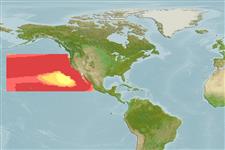Teleostei (teleosts) >
Anguilliformes (Eels and morays) >
Nemichthyidae (Snipe eels)
Etymology: Nemichthys: Greek, nema, -atos = filament + Greek, ichthys = fish (Ref. 45335); larseni: Named for Verner Larsen, who began the study of this species while at the University of Copenhagen..
More on authors: Nielsen & Smith.
Environment: milieu / climate zone / depth range / distribution range
Ecology
Marine; bathypelagic; depth range 170 - 1280 m (Ref. 96339). Deep-water; 47°N - 17°N, 170°E - 105°W
Eastern Pacific: Oregon, USA to central Mexico, including the Gulf of California; also Hawaii and north of Hawaii to about 38°N.
Size / Weight / Age
Maturity: Lm ? range ? - ? cm
Max length : 161 cm TL male/unsexed; (Ref. 40789)
Short description
Identification keys | Morphology | Morphometrics
Dorsal soft rays (total): 173 - 222; Anal soft rays: 164 - 208. Most easily distinguished from N. scolopaceus by its pale color; has more postorbital and preopercular pores. Rectangle formed by the lateral line pores is shorter and higher than in scolopaceus. Resembles N. curvirostris in its pale color but the subcutaneous dark bars are not as evident. May be instantly distinguished from curvirostris by the more numerous postorbital and preopercular pores and the much shorter and higher rectangle formed by the lateral line pores. Has smaller teeth than curvirostris.
Mesopelagic (Ref. 58302). Minimum depth from Ref. 58018.
Life cycle and mating behavior
Maturities | Reproduction | Spawnings | Egg(s) | Fecundities | Larvae
Nielsen, J.G. and D.G. Smith, 1978. The eel family Nemichthyidae (Pisces, Anguilliformes). Carlsberg Found., Dana-Rept. No. 88:71 p. (Ref. 7450)
IUCN Red List Status (Ref. 130435)
Threat to humans
Harmless
Human uses
Tools
Special reports
Download XML
Internet sources
Estimates based on models
Preferred temperature (Ref.
123201): 6.8 - 7.9, mean 7.4 °C (based on 6 cells).
Phylogenetic diversity index (Ref.
82804): PD
50 = 0.6270 [Uniqueness, from 0.5 = low to 2.0 = high].
Bayesian length-weight: a=0.00102 (0.00046 - 0.00225), b=3.06 (2.88 - 3.24), in cm total length, based on all LWR estimates for this body shape (Ref.
93245).
Trophic level (Ref.
69278): 3.5 ±0.5 se; based on size and trophs of closest relatives
Resilience (Ref.
120179): Low, minimum population doubling time 4.5 - 14 years (Assuming tmax>10).
Fishing Vulnerability (Ref.
59153): Very high vulnerability (90 of 100).
